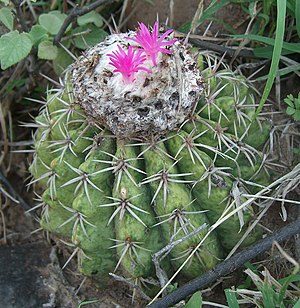Melocactus curvispinus
| Melocactus curvispinus | ||||||||||||
|---|---|---|---|---|---|---|---|---|---|---|---|---|

Melocactus curvispinus |
||||||||||||
| Systematics | ||||||||||||
|
||||||||||||
| Scientific name | ||||||||||||
| Melocactus curvispinus | ||||||||||||
| Whistle. |
Melocactus curvispinus is a species of plant in the genus Melocactus from the cactus family(Cactaceae). The specific epithet curvispinus means 'with curved spines'.
description
Melocactus curvispinus grows individually and has depressed spherical to short cylindrical, light to dark green, somewhat glauke shoots that reach a height of 6 to 30 centimeters with a diameter of 8 to 27 centimeters. The 10 to 16 ribs are pointed and sometimes become a little warty. The areoles that sit in their notches have sunk in somewhat. Some of the dirty white to almost black thorns emerging from the areoles are curved. The upright, 1 to 4 central spines, which can also be missing, are 15 to 52 millimeters long. Of the 6 to 11 (rarely more) radial spines, which are between 3 and 42 millimeters long, the lowest is the longest. From the comparatively small cephalium with a height of 3 to 4 centimeters and a diameter of 7 to 11 centimeters , reddish-brown bristles protrude clearly long.
The flowers emerging from the cephalium and towering over it by more than 10 millimeters open in the late afternoon. They are dark to light pink-violet, 18 to 43 millimeters long and have a diameter of 10 to 25 millimeters. The club-shaped fruits are slightly lighter at the base and are pink to bright red to deep magenta.
Distribution, systematics and endangerment
The distribution area of Melocactus curvispinus extends from Mexico to the south of Peru , from there to the northeast of Colombia and Venezuela and includes the Caribbean .
It was first described in 1837 by Ludwig Georg Karl Pfeiffer . The following subspecies are distinguished:
- Melocactus curvispinus subsp. curvispinus
- Melocactus curvispinus subsp. caesius (HLWendl.) NPTaylor
- Melocactus curvispinus subsp. dawsonii (Bravo) NPTaylor
- Melocactus curvispinus subsp. koolwijkianus (Suringar) G.Thomson
The subspecies curvispinus has strongly backward curved radial spines up to 28 millimeters long and is distributed in Mexico, Central America, Colombia and in the west of Venezuela at altitudes of 1500 meters. The subspecies caesius has almost upright radial spines or radial spines longer than 28 millimeters and is distributed in the Caribbean and the coastal areas of Colombia and Venezuela up to altitudes of 700 meters. The subspecies dawsonii occurs only in the Mexican state of Jalisco .
There are numerous synonyms as the type is very variable. A synonym for the subspecies Melocactus curvispinus subsp. caesius is Melocactus caesius H.L Wendl. (1840).
In the Red List of Threatened Species of the IUCN , the species is listed as " Least Concern (LC) ". H. listed as not endangered.
proof
literature
- Edward F. Anderson : The Great Cactus Lexicon . Eugen Ulmer KG, Stuttgart 2005, ISBN 3-8001-4573-1 , p. 424-425 .
Individual evidence
- ↑ Enumeratio Diagnostica Cactearum hucusque Cognitarum . Berlin 1837, p. 46 (online) .
- ↑ Melocactus curvispinus in the IUCN Red List of Threatened Species 2013.2. Posted by: Arreola, H., Ishiki, M., Terrazas, T., Hammel, B. & Nassar, J., 2009. Retrieved January 2, 2014.